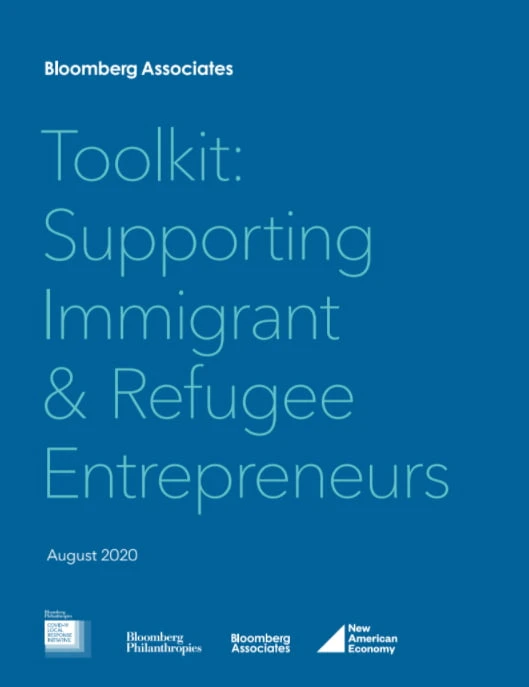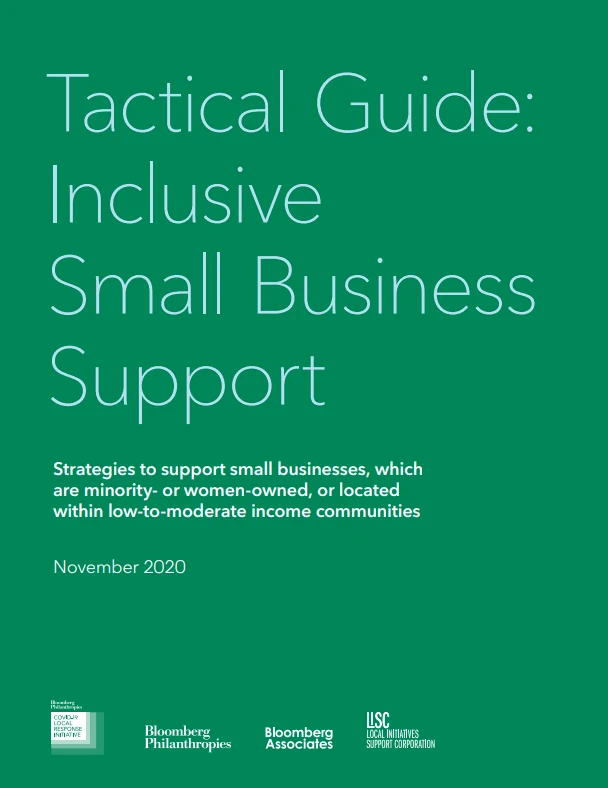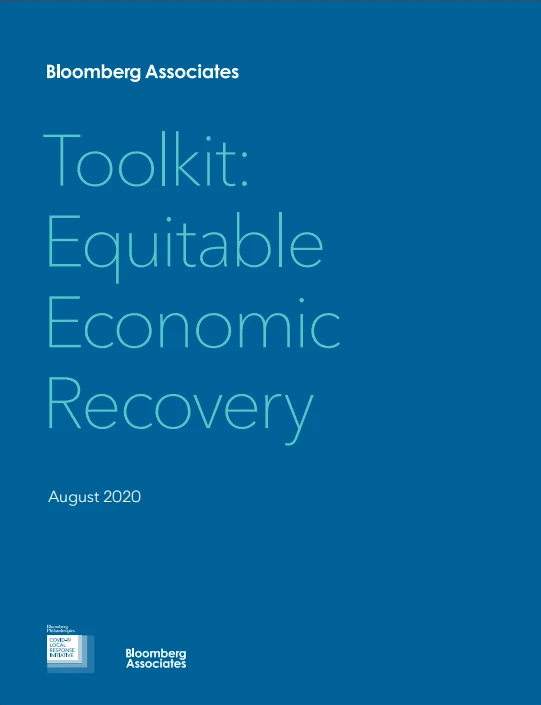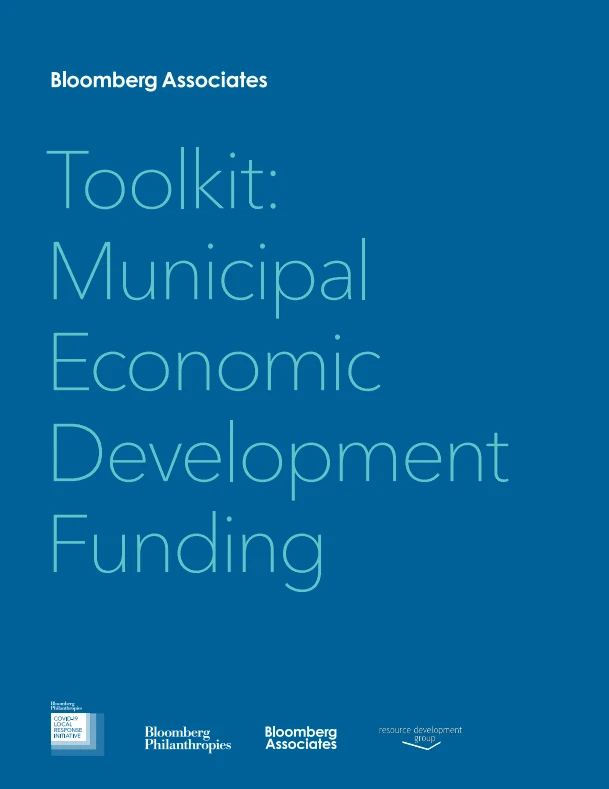COVID-19 Economic Response and Recovery
Cross-Sector coordination: creating a task force, committee or network to support new Americans
Short-term planning: ensuring an inclusive recovery
For cities that have not already convened a multi-sector set of partners to identify and address the needs of immigrant and refugee communities as part of their overall COVID-19 response and recovery planning, the first step should be to bring the right set of partners to the table.
This effort should be:
- Multi-sector: This group must include representation from local government, as well as organizations that serve immigrants and refugees, such as refugee resettlement organizations, local Offices of Immigrant Affairs, and other community-based organizations; and may also include chambers of commerce; universities; private corporations, community foundations, and financial institutions; and faith-based organizations.
- Data-driven: Cities should make use of existing metro-level research on immigrants and refugees (e.g., New American Economy’s Map the Impact which provides metro-level economic and demographic data about immigration), as well as local surveys of immigrant and refugee business owners. Cities should collect data on country of origin and/or language requests as part of service delivery (e.g., through small business relief funds), taking care to not include questions about immigration status or keeping such information confidential, if it is necessary to collect.
- Empowered to make and implement recommendations: Recommendations made by this group should be advanced as part of the city’s overall response, adaptation and recovery effort, including policy change and the development of new targeted programming.
- Locally and/or privately funded: Due to federal funding restrictions, immigrants — especially undocumented immigrants — may be left out of COVID-19 relief funds and other forms of federal aid, assistance or benefits. Unrestricted local public dollars or private funding should be tapped to ensure that all small business owners, regardless of immigration status, are able to access the necessary support and resources.
Long-term planning: promoting inclusion through systems change
This same Task Force or Committee structure should also be tasked with developing a longer-term, multi-year inclusion plan — if such a plan is not already in place. Cities with strong immigrant inclusion plans typically follow a 6-month to 1-year timeline that includes the following core elements.
1. Partner with a university or research institution to gather data on immigrant and refugee entrepreneurship. Research studies have catalyzed efforts to support immigrant and refugee businesses by providing greater knowledge of the existing community, helping to identify the types of businesses and sectors in which immigrant entrepreneurs are concentrated, uncovering common challenges and concerns, and providing high-level talking points on the positive economic impact.
- St. Louis, MO: A pair of studies conducted by a St. Louis University economist highlighted the economic impact of immigration on St. Louis and identified immigrant-driven strategies for promoting economic growth in the region, leading to the creation of the St. Louis Mosaic Project in 2012. Both studies were funded by the William T. Kemper Foundation.
- Houston, TX: A report produced by New American Economy found that 13.4% of Houston’s immigrant population were self-employed, outpacing the national average for immigrants (11.9%) and the U.S.-born (8.8%). The study also found that immigrants in Houston were 53.2% more likely to be entrepreneurs than their U.S.-born counterparts, and that they generate more than $3 billion in business income annually.
- New York, NY: A study conducted by the Association for Neighborhood and Housing Development, which included surveys and focus groups of immigrant business owners, found that 56% of immigrant business owners live in the neighborhood in which they operate their business, and that rent burden was the top concern across all neighborhoods surveyed.
2. Create a multi-sector steering committee or task force charged with developing recommendations to support foreign-born entrepreneurs. This group should include representatives from local government, chambers of commerce, universities, community-based organizations, financial institutions and other organizations. Entrepreneurship may be just one focus area among several — with the goal of facilitating immigrants’ economic, civic, and social integration.
- Chicago, IL: The Chicago New Americans Plan, spearheaded by the Chicago Office of New Americans in partnership with a 50-person multi-sector advisory committee, resulted in 27 recommendations, including 5 to support immigrant entrepreneurship. These included creating a small business incubator, a “Chamber University” to train chamber of commerce leaders to better support immigrant entrepreneurs, and efforts to promote tourism in immigrant neighborhoods.
- Salt Lake County, UT: The Salt Lake County Welcoming Plan — supported by New American Economy, Welcoming America, the Salt Lake Chamber and the Salt Lake County Mayor’s Office — resulted in three overarching goals and 11 strategies to support new Americans, including a recommendation to incorporate business centers serving immigrants and refugees into the mainstream Business Resource Center network.
3. Gather feedback directly from community members and entrepreneurs. Soliciting public comment, and creating opportunities for two-way dialogue between city leaders and the community, ensures that the recommended strategies are actually addressing the need. This also helps build public support and buy-in for the plan.
- Akron, OH: As part of a year-long planning process to develop a Strategic Welcome Plan, the City of Akron and Summit County hosted a public Welcome Summit — attended by more than 250 community leaders and residents — to gather direct feedback. Access to capital, business training, and the creation of a business incubator were identified as community priorities.
- Dayton, OH: The City of Dayton solicited public feedback on the Welcome Dayton Plan, which included the creation of an immigrant entrepreneur ambassador program to support a local immigrant commercial corridor.
4. Create a formal, long-term structure to advance the recommendations. To ensure implementation of recommended programs and policies, cities often establish long-term structures, such as a task force or Office of New Americans, staffed by local officials who work directly with community partners. This can include regular meetings, subcommittees focused on key issues such as entrepreneurship or economic development, and public-private partnerships to advance inclusion work.
- Atlanta, GA: Welcoming Atlanta, an initiative started out of a multi-sector strategic planning process, is part of the Atlanta Mayor’s Office of Immigrant Affairs, and works to advance programs and policies that improve quality of life for newcomers — including multilingual COVID-19 resources.
- Lincoln, NE: The Lincoln New Americans Task Force includes public and private organizations and community members who meet regularly to help promote policy change and programming that facilitates immigrant integration. The Task Force recently published its first-ever New Americans Task Force Immigrant and Refugee Survey Report, which included a focus on economic development and identified barriers to full participation.
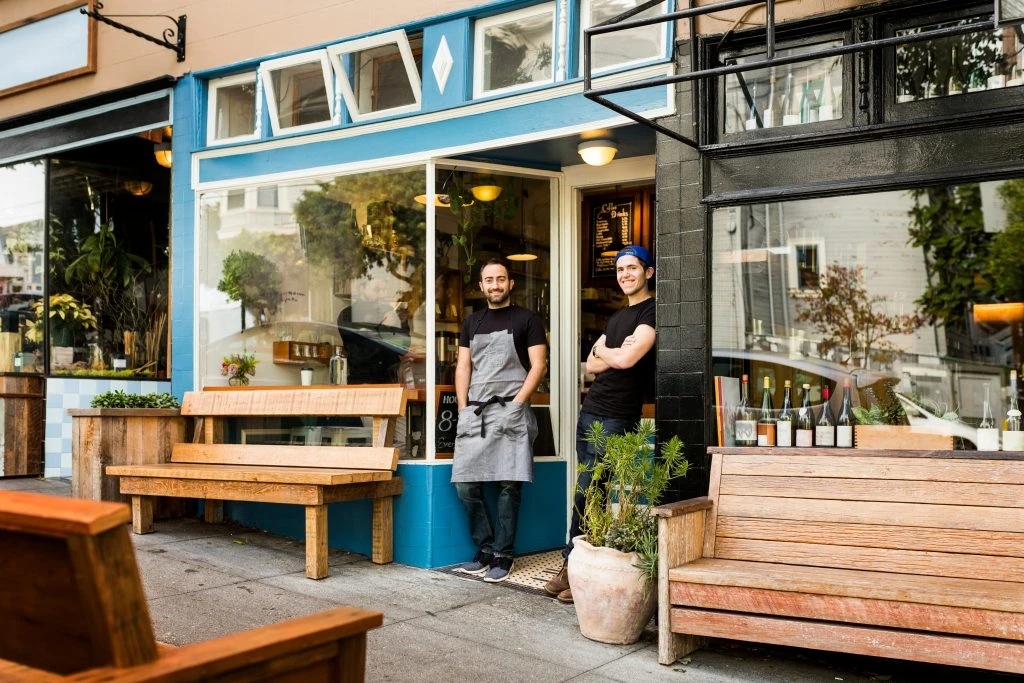
Learn more about the Toolkit
COVID-19 Economic Response and Recovery
Connect Small Businesses to a Mentorship Network
Action:
Work with partners to create and expand free mentorship programs for MWBEs.
Why:
An estimated 81% of funding for businesses comes through personal net worth, family wealth, or connections to networks. The lack of business role models is particularly acute for Black and brown business owners, impeding their ability to start businesses. Mentorship programs are an integral part of an entrepreneurial ecosystem and are a low-cost and powerful strategy to support MWBEs.
Case Study
Start Small Think Big – U.S.
Start Small Think Big is a nonprofit organization based in New York City and the Bay Area that provides remote support to small businesses across the country through a network of professional volunteers who provide legal, financial, and marketing services at no cost.
The organization helps small, MWBEs, entrepreneurs from disadvantaged groups, and businesses located in LMI communities with revenues under $1 million. Each Start Small Think Big client receives approximately 50 hours of one-on-one pro bono assistance each year, valued at more than $30,400.
During intake, the organization conducts a needs assessment of each business to identify areas for improvement. The assessment is used to match the entrepreneurs to appropriate volunteers. The organization conducts periodic follow-up assessments (6–, 12–, and 24–months) to assess the business’s growth and success. Clients can expect to receive assistance for up to 12 months but can extend Start Small Think Big services if they still qualify.
Start Small Think Big works with government entities to act as an add-on or complementary service to existing business support programming.
In response to COVID-19, Start Small Think Big expanded eligibility requirements for businesses and created a rapid response program, which offers short-term coaching for 1–2 sessions. The sessions initially focused on connecting entrepreneurs to funding opportunities but have expanded to focus on loan forgiveness, contract negotiations, leases, and marketing.
In 2019:
- 97% of the organization’s clients were MWBEs
- Over 2000 skill-based volunteers provided pro bono legal, financial, and marketing support to more than 1300 small businesses, valued at over $14 million.

How to Adapt This Approach:
- Work with partners (e.g., local/ethnic chambers, technical assistance providers, merchant groups) to assess the mentorship needs of local businesses, particularly MWBEs. Conduct a survey, hold focus groups and interviews with entrepreneurs to identify gaps and existing resources
- Identify existing providers of free or low-cost mentorship services in the city or region
– Determine if they can scale their existing programming to address the service gaps identified in the needs assessment
– Ensure programming is designed to support MWBEs
– Work with philanthropic and corporate partners to fund the expansion of programming at the existing partner - If a local partner is not able to meet this need, work with national organizations, such as Start Small Think Big, to connect their services to MWBEs in your city. Again, work with philanthropic and corporate partners to fund this expansion of services
- Integrate service into business support system (Action 2A) to align with other services, coordinate on referrals, and track client experience
- Launch program with active outreach and media campaigns. Leverage partners in the community to reach business owners (e.g., merchant associations, local/ethnic chambers, community groups, etc.)
- Measure and publish KPIs on a regular basis. Include aggregated demographic and neighborhood data on entrepreneurs being served, services provided, outcomes, etc. (See KPIs section)
Learn more about the Tactical Guide
Action:
Work with nonprofit, academic, philanthropic and business partners to create and grow an entrepreneurial ecosystem tailored for underserved small businesses.
Why:
The success of entrepreneurs depends on having a strong community that they can draw on to help them start and grow their business. By creating inclusive ecosystems cities can accelerate the startup and growth of MWBEs.
Case Study
Russell Center for Innovation and Entrepreneurship (RCIE) – Atlanta, GA
In Atlanta, Black entrepreneurs and small business owners are often cut off from the resources they need to succeed. This challenge has been exacerbated by COVID-19 which has disproportionately impacted the Black community and made the growth of black businesses more important than ever.
Founded in 2019, RCIE was created through a donation from the Russell Family Foundation to grow access to entrepreneurship throughout the Black community and empower Black entrepreneurs to turn their ideas into enterprises, in a place made just for them.
Housed in a 50,000+ square foot building that offers access to affordable coworking, convening, and meeting innovation space. The center is located in the heart of an Opportunity Zone in Atlanta’s Castleberry Hill neighborhood, close to the Atlanta University Center and historic HBCU communities.
Prior to its launch, RCIE engaged 1,500 Black entrepreneurs in Atlanta to better understand their needs. Overwhelmingly, the number one answer was “community.”
To address this, RCIE developed a theory of change and a program model to help Black entrepreneurs traverse the special barriers they face to build thriving businesses. RCIE provides community, resources, mentors, technical assistance, enriched learning, and access to deep networks that extend beyond the center.
Services Include:
- Community: Affordable hot desks, dedicated desks, and office space. The community also allows members to have peer accountability teams and conference/meeting space. Members also have access to high-speed internet, copy/ print shop, and a company mailbox
- Technical Assistance: Access to a state-of-the-art A/V technology and podcast studio, a pipeline to diverse tech talent through local universities and partnerships, and technical assistance provided by the GSU/UGA Small Business Development Center.
- Access to Capital: Help accessing capital, one of the biggest barriers to Black entrepreneurship. The building has created a “Capital Corridor” space that is dedicated specifically for access to capital, and investment readiness programming.
- Accountability & Mentorship: One-to-one coaching, individualized support and guidance, peer-to-peer learning, and a business mentor network. Members are connected with Black teachers and mentors who have experienced the entrepreneur journey firsthand.
- BIG I.D.E.A.S Platform: Is a co-design model called BIG I.D.E.A.S. that equips entrepreneurs to move along path that includes the following stages — from curiosity to concept (Inspire); from concept to company (Develop); from company to business (Execution), from business to ownership & growth (Accelerate); and from ownership & growth to wealth (Scale)

How to Adapt This Approach:
- Identify a lead for the initiative
- In most cases, a non-City organization (nonprofit, chamber, philanthropy, academic, etc.) is best positioned to house initiative
- The individual leading the initiative should have extensive private sector experience, have credibility within the community of entrepreneurs where the initiative is focused, and preferably be an entrepreneur as well
- Cities should leverage their convening power to galvanize partners, support fundraising, and focus on City controlled areas where it can accelerate or remove barriers to entrepreneurship
- The lead organization should engage and assess the current ecosystem
- Reach out to local business leaders and entrepreneurs to identify gaps in existing programming and opportunities
- Outreach to communities of color and low-income individuals to understand the needs of all communities
- Connect with startup and small business groups, local nonprofits, educational institutions, philanthropic partners, and business leaders to ensure participation. Part of the program’s benefit should be to offer networking and mentoring opportunities with established leaders
- Use data (e.g., from Kauffman foundation’s My Sidewalk) to demonstrate where potential gaps and opportunities for entrepreneurship exist in the community
- The lead organization should build a coalition of partners to support the initiative, which could include education institutions, VCs, successful founders, corporate partners, and service providers (e.g., lawyers, bankers, accountants, real estate technical assistance providers). Ensure partners are representative of the community the initiative intends to focus on
- Work with the coalition of partners to develop a proposed initiative to build out the entrepreneurial ecosystem in the city. The initiative could include:
- A physical center like RCIE, which focuses on providing all the support needed for a specific community of entrepreneurs
- An initiative to join up a network of existing coworking spaces, accelerators, entrepreneurship programs, events, etc. and connect it to MWBE or LMI entrepreneurs
- The designation of an entrepreneurial ambassador who serves as a single point of contact to navigate and connect entrepreneurs to the ecosystemThe proposal will vary depending on the project but should include: the goal, the need/ opportunity, the coalition of partners, the program design, location, staffing, budget, metrics, and timeline/next steps
- Use the proposal to raise funds for the initiative. Pitch foundations, banks, and corporations on contributing financially, providing in-kind support, or advising the program. Start with the coalition partners who have helped develop the initiative
- Launch and implement initiative
- Track and publish KPIs on a regular basis. Include aggregated demographic and neighborhood data on entrepreneurs being served, services provided, outcomes, etc. (See KPIs section)
Learn more about the Tactical Guide
Problem:
The availability of funds is not enough to ensure the success of local businesses. In fact, funds without support and technical assistance can create problems for businesses. But technical assistance programs are not enough; the success of entrepreneurs depends on having a strong community of mentors that they can rely on to help them along the process of starting and scaling a business — whether it be answering questions about business planning and strategy advice, partners, the local market, funding /grants, or even getting advice on who to go to.
This ecosystem must be diverse and available to all in the community. An estimated 81 percent of funding for businesses comes through personal net worth, family wealth, or connections to networks. The lack of business role models is particularly acute for Black and brown business owners, impeding their ability to start businesses. Ensuring that these individuals have an entrepreneurial ecosystem is critical to ensuring equity in a city.
Action:
Cities should launch programs, leveraging business and community partners, to foster an entrepreneurial environment. These actions should focus around connecting entrepreneurs and facilitating access to government and support services, such as mentoring. They usually should not be led by the city, but the city has a key role to play encouraging, galvanizing, connecting, and facilitating. These actions are also incredibly important, are foundational to ensure the success of other programs in this toolkit, and are low-cost.

Case Study
Independence, OR: Entrepreneurship Initiatives
Independence, Oregon (population ~10,000) was a thriving agricultural City that was facing an uncertain and concerning economic future in the 1990s due to the changing employment landscape. City officials decided to take decisive action to reverse this decline and prepare the economy for the 21st century by centering entrepreneurship. Several initiatives were launched as part of their 2020 Vision plan to build an entrepreneurial ecosystem.
One of the catalysts for building the entrepreneurship ecosystem in the city was attracting Indy Commons, a coworking space that offers members the ability to network and collaborate. Created by a private entrepreneur who partners with the City to host different events, ranging from practical skills (e.g., how to create a “Google My Business” account) to information sessions from government officials. Membership is offered at several levels – with rates starting as low as $75 a month – to enable local entrepreneurs with little capital to take advantage of the space. It has been so popular that it recently moved to a larger space to handle additional capacity. One of the primary benefits of the space is the high-speed broadband made possible by city investments.
Related to Indy Commons is IndyIdeaHub, a speaker series established to facilitate connections between local entrepreneurs, city officials, and business leaders. The non-profit will also be providing one-on-one technical assistance to local business owners. Leveraging Kauffman Foundation’s 1 million cups as a model program, the team hosts regular events centered around entrepreneurship and sharing best practices. Events are normally hosted at Indy Commons and complimentary coffee and pastries are provided by local businesses. The organization hosts events with different themes such as starting a business, accessing capital, and crowdfunding. They also host regular “Fail Fests” and bring in successful entrepreneurs to discuss previously failed enterprises and show how to take appropriate risks.
Given the community’s strong agricultural roots, the City has been examining opportunities to incorporate food-related entrepreneurship into the program. The local school district is working to establish an Agricultural Technology Education Center on a 10-acre property in the county. Students will be able to learn about critical agriculture skills and cutting edge technology. The City is also partnering with Oregon State University to offer programming to aspiring entrepreneurs and business owners.
Its work has received acclaim and the town is serving as a model to other cities thinking about how to promote entrepreneurship. City officials proactively meet with prospective entrepreneurs and small business owners to identify barriers and make it easier to do business. The City has even attracted a new hotel. Despite Independence’s successes, it is continuing to focus on building an entrepreneurial ecosystem. The City has started planning its 2040 Visions to further entrepreneurship and innovation. IndyCommons is also considering building a podcast and video room to meet entrepreneurial needs in today’s post-COVID world.
Another example:
The Russell Center for Innovation and Entrepreneurship (RCIE) is a new center in Atlanta, created to empower Black entrepreneurs and small business owners. Funded by a grant through the Russell family, the RCIE will have several key elements: incubator, accelerator, and innovation lab. It will serve as a convener to highlight resources, networks, mentors, technical assistance, and education opportunities for Black Atlantans. RCIE will have a physical coworking and convening space.
Note: RCIE was funded through a private philanthropic partner. Cities should explore whether this is a possibility; otherwise, they should consider donating space in City buildings for convenings or identifying local partners (e.g., coffee shops) that can host events.
How To:
- Engage and Assess Your Current Ecosystem
- Reach out to local business leaders and entrepreneurs to identify gaps in existing programming and opportunities
- Be sure to reach out to communities of color and low-income individuals to understand the needs of all communities
- Connect with startup and small business groups, local non-profits, educational institutions, philanthropic partners, and business leaders to ensure participation. Part of the program’s benefit should be to offer networking and mentoring opportunities with established leaders.
- Use data (e.g., from Kauffman foundation’s My Sidewalk) to demonstrate where potential gaps and opportunities for entrepreneurship exist in the community.
- Entrepreneurship convenings
- Consider philanthropic models (e.g., 1 Million Cups) as a model for this.
- Identify space(s) that can be used for gatherings.
- Spaces should be easily accessible and conducive to small group gatherings (e.g., coffee shops)
- Plan first convening with at least 2 entrepreneurs presenting their businesses and gathering input
- Establish a recurring schedule for convenings, with a set time and place
- Establish clear success metrics and modify the program as necessary
- The convener does not need to be the city officials — rather it can be successful entrepreneurs in the community. The city’s role may be helping identify the right leader in the community and spreading awareness.
- Regulation Reform
- Meet with local business leaders and entrepreneurs to discuss existing government regulations and burdensome processes
- Direct the city attorney’s office to conduct a review of regulations with a particular focus on identified roadblocks.
- Require “positive justification” (e.g., clean sheet regulations) for regulations that remain for businesses
- Modify/eliminate unnecessary regulations. Work with city council and relevant stakeholders to make changes as necessary.

Benefits:
- Establishes a network that businesses can leverage to get advice and support
- Enables entrepreneurs to see success stories and understand best practices
- Low cost to implement
Risks:
- Can be lofty, not actionable if the group does not provide tangible benefits
- Runs the risk of only helping certain segments of the population if it does not include a diverse group of businesses
Impact: Medium (low in isolation but enables many other actions)
Implementation time: Slow
Cost: Low. These programs can be very low cost and likely only require a coordinator role. Entrepreneurial partners and community leaders should help lead these efforts.
Learn more about the Toolkit
Action:
Use land powers and incentives to support inclusive development projects, which convert abandoned or vacant buildings in disinvested neighborhoods. Promote the projects to philanthropic, corporate, or other government funders.
Why:
In this way, you will support local businesses and create short-term construction jobs as well as good, neighborhood jobs, and fill a long-time vacant building.
Case Study
7800 Susquehanna – Pittsburgh, PA
7800 Susquehanna is a 150,000 square foot hub for manufacturing, makers, small businesses, nonprofits, and job training in a historically Black neighborhood of Pittsburgh.
Bridgeway Capital, a local CDFI, purchased the former manufacturing facility to ensure that the building’s reactivation and future use would align with the community’s plans for economic revitalization benefiting local residents.
To purchase and renovate the property, Bridgeway has invested $13 million to date. It is financing the project through a mixture of philanthropic funding, government grants, and New Markets Tax Credits equity investments.
Bridgeway prioritizes maker/manufacturer and workforce development tenants, which create good-paying jobs and training benefits for the surrounding community. The building is fully leased to 22 tenants, who collectively employ 90 individuals. Also, the workforce development nonprofits annually graduate 75 individuals into living-wage jobs. Many of the building’s employees and workforce are residents from the immediate and surrounding communities.
Bridgeway also created ORIGINS, a business support program, which promotes Black makers and manufacturers. ORIGINS has a dedicated 750-square-foot space in the building for Black makers and manufacturers looking for their first business space.
How to Adapt This Approach:
- Identify former industrial buildings in disinvested neighborhoods, which are ripe for redevelopment
- Deploy public capital funds to support the acquisition and development of industrial properties
- Develop relationships with local or national CDFIs and other community development entities to advocate for redevelopment uses that retain the area’s manufacturing legacy and provide local jobs
- Ensure a diversity of spaces and rents in these districts by supporting mission-driven nonprofit ownership
- Identify and facilitate local, state, and federal sources of funding for the project including tax increment, New Markets Tax Credits, Opportunity Zones, and other federal sources
- Cities can support the project by facilitating land use changes to accommodate the project, investing in infrastructure, and providing grants for pre-development costs/environmental clearance
- Build local coalitions to advocate for philanthropic investments
- Connect small business support programs and workforce development services and provide tailored support to meet the local community’s needs
Learn more about the Tactical Guide
COVID-19 Economic Response and Recovery
Access to Capital: Remove Barriers to Recovery and Growth
Background
Immigrants are roughly twice as likely as the U.S.-born to start small businesses, but they have trouble accessing the necessary capital to grow and are more likely to stay small or fail earlier as a result.
Issues such as poor or limited credit history, lack of financial literacy, and lack of familiarity with and access to mainstream financial services create unique hurdles for immigrant and refugee entrepreneurs.
Strategies:
A. Leverage the expertise of CDFIs and CDCUs with experience serving immigrant and refugee communities. Organizations that offer lending or micro-lending services to low- to moderate-income borrowers from diverse backgrounds are more likely to provide flexible, low-interest products that meet the needs of immigrant and refugee entrepreneurs. These organizations should be equipped with the staff and resources to provide linguistically and culturally competent services. For example, Inclusiv, which is a national network of credit unions, recently launched the Inclusiv Resilience Fund, which is “an opportunity for minority designated credit unions to receive funding to expand the scope and reach of their financial programs and services for the benefit of the people and communities they serve.”
B. Create a technical assistance network to help business owners navigate the process. Mainstream lending institutions may lack the expertise to provide linguistically and culturally competent services to immigrant and refugee business owners, and may also lack the flexibility to provide products that meet the particular needs of these communities. At the same time, foreign-born and other underserved entrepreneurs may have difficulty navigating the process of applying for small business loans and grants, including through recent relief packages. A technical assistance network that brings together business development organizations, lenders and organizations that serve the target population can help collectively address these challenges.
For example:
The City of Baltimore and the Baltimore Development Corporation have created a TA network with the Baltimore Small Business Support Fund to help immigrant, minority and women-owned businesses access COVID-19 relief and other forms of capital and investment.
C. Support the creation of specialized lending models. Certain lending models and products have emerged in recent years that are designed to serve specific community interests and needs. For example, some faith-based communities — including Muslims as well as some Jewish and Christian groups — are prohibited from paying or receiving interest on financial transactions, which means they may not use most mainstream financial services in the U.S. The Neighborhood Development Center in Minneapolis, MN now provides Islamic financing for small businesses to Muslims and non-Muslims, through an arrangement where no interest is charged. Other models, like the San Francisco-based Mission Asset Fund’s lending circles, allow communities to pool money to invest collectively in a business.
Case Study
LISC Small Business Recovery Grant for Minority, Immigrant and Women-Owned Businesses, Indianapolis, IN
Highlights:
- The Indianapolis Small Business Recovery Grant for Minority, Immigrant and Women-owned Businesses offers grants of $5,000 to Minority, immigrant (including undocumented) and/or women-owned businesses that have been impacted by COVID-19.
- Local Initiatives Support Corporation (LISC) Indianapolis is a local office of a national organization of nonprofits that centers community development and focuses on connecting underinvested communities to public and private resources. LISC Indy mobilizes these resources to provide financing opportunities, technical assistance, and training programs to neighborhoods in need.
Overview:
At the onset of the pandemic, LISC was quick to respond and mobilize support for the communities hit hardest, including minority small businesses which have been disproportionately impacted by the financial repercussion of this crisis. As an established community development financial institution and resource connector in the community, LISC immediately recognized that in order to survive these small businesses were in urgent need of quick and accessible capital. To that end, they created the Small Business Recovery Grant for Minority, Immigrant and Women-owned Businesses. Today, LISC has received a total of 1,017 grant applications, 93 of which were in Spanish, and have awarded a total of 25 recovery grants in Round 1 and are in the process of finalizing and announcing its second round of 25 grantees.
Program Components:
- Eligibility: Applicants must be a minority, immigrant or women-owned small business that has been impacted by COVID-19. They can have up to 10 employees and must be located within one of LISC’s targeted geographies in Indianapolis.
- The application: To ensure that the application itself wasn’t a barrier to entry, LISC made the application as simple and easy to fill out as possible and refrained from asking about an applicant’s immigration status, to ensure that they maintained their privacy and trust. They also provided the application and FAQ page in Spanish to help remove any potential language barriers.
- Outreach: LISC utilized trusted and grassroot networks, social media and local news outlets to make sure that their target audience was aware of the grant. This helped them reach a pool of applicants who may not have had previous awareness of LISC or have limited engagement with small business support networks. LISC also spent a great deal of time in direct outreach and technical support via phone calls, texts and emailing with applicants. Particularly as it related to an individual’s uncertainty about their eligibility because of their immigration status.
- Review process: all applicants who did not meet the published criteria were not considered for this grant. All eligible applicants were then weighted and ranked by categories like annual revenue, years in operation, decrease in sales, etc. to identify the top 50-60 candidates for which a group of trusted community-based organizations including Forward Cities, Kheprw Institute, Indy Chamber Hispanic Business Council, Indy Black Chamber of Commerce, and the City of Indianapolis Office of Women and Minority Business Development further reviewed to select finalists.
- Funding: The grants were privately sourced from grants and donations by the Indianapolis Foundation, Glick Philanthropies, and Regions Bank, Chase Bank, MJ Insurance and IDS. Private funding was unrestricted and therefore could be used to support any qualifying business owner, regardless of immigration status.
Adapt this Approach:
- Identify local or private funding sources to ensure grant funds are unrestricted and accessible by business owners regardless of immigration status.
- Partner with community-based organizations and trusted networks for outreach and grant renewal.
- Translate loan applications in your community’s most common languages and provide multilingual application support.
Learn more about the Tactical Guide
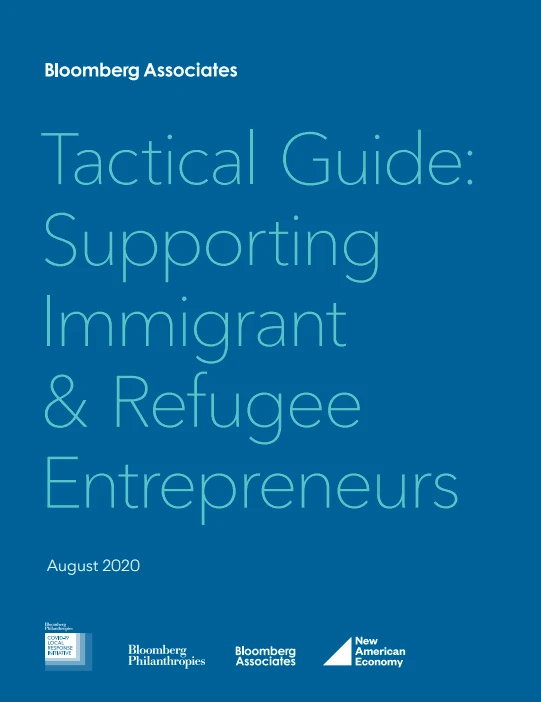
COVID-19 Economic Response and Recovery
Create a Coordinated Business Support System with Inclusive Outreach and Navigation
Action:
Lead the way in aligning small business services into a more unified, client-centered, data-driven business support system with a focus on MWBEs and LMI small businesses. The system should have a consolidated point of entry for small businesses support to triage, navigate, and refer entrepreneurs to the city’s broader business support network.
Why:
A more coordinated business support system will result in an improved client experience, better services, stronger providers, and clearer reporting on outcomes and impact.
Coordinated outreach, navigation, and referral to technical assistance providers will deepen the reach of programs, improve outcomes, and be particularly impactful for MWBE and LMI small businesses, which are often not able to access government small business programming.
Case Study #1
Inclusive Business Resource Network (IBRN) – Portland, OR
Prosper Portland, the Portland economic development agency, is focused on creating and improving systems that serve entrepreneurs, particularly for women and people of color. Through research and outreach, Prosper Portland recognized that women and minority entrepreneurs need to:
- Be in a community with other entrepreneurs who look like them
- Have access to mentors who share similar experiences
- Have access to a coordinated network of support providers
In January 2016, Prosper Portland launched the IBRN, a citywide program that supports a business from startup through growth, ensuring that technical assistance leads to wealth creation for underrepresented entrepreneurs.
The IBRN comprises of 20 organizations, which offer three levels of service:
- Light-touch (5–10 hours a year) such as the PPP loan walk-through, where a client can receive assistance with specific questions while applying for loans, as well as help accessing business services through culturally specific business navigators or geographically based business advisors
- Long-term (30+ hours a year) such as 1:1 technical assistance, peer cohort classes, and growth plan coaching
- Specialized services driven by the business’s need, such as legal support, credit coaching, marketing, and accounting programs
Prosper Portland serves as IBRN’s funder and convener. The network meets monthly to collaborate on client needs, share information, conduct trainings and work in topic-specific committees on program design iteration. The goal is to grow a community of thought leaders and business advisors who specialize in culturally specific business support.
The IBRN’s support providers use a standardized badging system to track long-term client progress. Badges reflect stages of business growth: Strong & Stable, Growth, Scale and Launch. Each badge has 9–12 different milestones, with the completion of four milestones required to earn each badge. Outcome data is reported annually in an IBRN Progress Report.
In 2018–19, the network:
- Served 1,043 entrepreneurs — 72% were people of color and 58% were women.
- Supported 100+ profitable businesses, which retained 640 jobs, and created 504 jobs.
89% of supported business owners who responded to the annual program survey felt their business advisor respected their culture/made them feel welcome, 73% said it was easy to access services from providers, and 57% said they have seen sales increase as a result of the support.
Case Study #2
Technical Assistance Partnership – Baltimore, MD
In April 2020, Baltimore Development Corporation (BDC) and the Baltimore Small Business Support Fund (BSBSF) created the BDC-BSBSF Technical Assistance Partnership to help small businesses struggling to access capital due to COVID-19 by connecting them to a network of technical assistance providers.
The partnership consists of 19 local organizations — 8 are small business technical assistance providers and 11 are nonprofits and community organizations that bring connections to the community and provide targeted outreach.
The BDC serves as the partnership’s central coordinator and is responsible for communications among the partners, directing technical assistance requests to appropriate organizations, disseminating updated information about new financial assistance opportunities, developing partnerships with lenders and other support organizations, and capturing and sharing data related to the partnership’s efforts.
The BSBSF provides grant funding, approximately $125,000 per year, to each of the nonprofit technical assistance providers to increase their capacity and support for entrepreneurs of color looking to access capital. Community outreach organizations receive approximately $10,000 per year to execute targeted community outreach.
The partnership has prioritized outreach to MBEs, assessing whether programs were appropriate for them, identifying appropriate lenders, assisting business with online applications and providing language assistance.
The BSBSF is supported by a number of philanthropic foundations and financial institutions.
The BDC-BSBSF Technical Assistance Partnership resulted in a singular, coordinated small business support ecosystem that brings Baltimore’s various small business support organizations together, minimizes the duplication of efforts, and streamlines delivery of and referrals to technical assistance — improving the experience for small business clients.
While it was created to respond to COVID-19, the BDC and BSBSF are in discussions to continue the partnership, with a focus on helping MWBEs access long-term recovery and growth capital.
As of June 30, the partnership had engaged over 1,000 small businesses. Of those small businesses, 48% are minority-owned and 32% are Black-owned. In addition, 56% are women-owned.
Most of the businesses assisted by the partnership are microenterprises, 40% are sole-proprietors or self-employed, 37% have between 2–5 employees, and 23% have more than 5 employees.
An initial business survey showed that out of 24 businesses who received assistance in applying for the Paycheck Protection Program (PPP) loans, 83% were approved. All were minority-owned small businesses.

How to Adapt This Approach:
- Assess the effectiveness of the current small business support system
– Reach out to a diverse set of small businesses, business groups and local stakeholders through one-on-one interviews, focus groups and surveys. Be sure to engage communities of color and LMI businesses to understand the specific needs of their communities
– Evaluate reporting and outcome data from business support providers and any City run programs. Review the profile of which business (e.g., sector, size, business type, ownership profile, neighborhoods, etc.) are receiving the most and least amount of services and how effective those services have been - Build a coalition of business support providers (e.g., nonprofits, academic, other government agencies, etc.) to review findings of the assessment, agree on shared goals for aligning the system and develop a project plan to advance these goals
- Develop a comprehensive map of the small business support services available in the city.
– Take a client centric approach to identify missing services, determine gaps in the system where entrepreneurs get stuck or fall through the cracks, and assess which services are most and least effective
– Consider language access, cultural competency, outreach/proximity to high need communities and other factors when evaluating existing services - Working through the coalition of business support providers, develop an implementation plan with specific actions to create a more unified system. These actions could include:
– Establish one support provider or City agency to serve as the primary point of entry for small business services— triaging, navigating, and case managing the small business through the business support system
– Draw on the comprehensive service map to create a consolidated business portal designed for small business clients to quickly understand, navigate and access business services
– Agree to a uniform set of KPIs. Develop a unified data system/client relationship management (CRM) tool to track a business clients experience across the business support system and measure impact
– Create a “community of practice” with regular meetings so providers can coordinate on cases, share best practices/challenges, conduct trainings and coordinate on the delivery of the implementation plan
– Develop new programming to address gaps in services. Cities could fund these services directly or advocate for philanthropic, corporate or other governmental funding sources.
– If the City is contracting for business support services with nonprofit providers, include as part of the contract requirements to coordinate on the above elements - Partner with merchant associations, local/ethnic chambers, and other community groups, which are trusted partners in the communities, to drive outreach, promote and connect harder-to-reach businesses to business support
- Track and publish KPIs on a regular basis. Include aggregated demographic and neighborhood data on businesses being served, services provided, outcomes, etc. across the entire system. (See KPIs section)
Learn more about the Tactical Guide
COVID-19 Economic Response and Recovery
Maximize Federal Funding Sources by Using HUD’s Section 108 Loan
Action:
Municipalities should pursue HUD funding and specifically section 108 loan guarantees of the Community Development Block Grant program, to help offset project costs.
Why:
- Section 108 enables exceptionally low interest-rate-subordinate funding for eligible projects.
- The funds are fairly flexible in terms of use.
- The program has been run since 1974 and is, therefore, reliable.
- To date, there has not been a single default under the program.
Background:
HUD Section 108 increases the capacity of block grants by enabling a community to borrow up to five times its annual CDBG allocation.
The community pledges its current and future CDBG allocations as security for the loan. This does NOT mean that the city will forfeit its CDBG allocations. Normally, the borrower (in the case study below, the city) pays back the loan via revenue created through project proceeds. It is only if the proceeds are not forthcoming that HUD would use pledged CDBG funds to continue to make payments on the loan.
CDBG
The Community Development Block Grant (CDBG) Entitlement Program provides annual grants on a formula basis to entitled cities and counties to develop viable urban communities by providing decent housing and a suitable living environment and by expanding economic opportunities, principally for low- and moderate-income persons.
Section 108 funding can be used to:
- Acquire real estate. For example, Addington Ridge, NC used $694,000 of Section 108 guaranteed loan funds to acquire and improve a site in the Deep River neighborhood, which it then sold to a developer for affordable housing.
- Construct, reconstruct, or install public facilities (such as streets, sidewalks, and other site improvements).
- Make related relocation, clearance, and site improvements.
- Rehabilitate a publicly-owned property. For example, Anaheim, CA used $7 million of Section 108 guaranteed loan funds to restore a historic orange packing facility. The building was rehabilitated into a food market, which has catalyzed economic development in the downtown neighborhood.
- Lend money to a for-profit business, in order to support economic development goals. For example, Reading, PA used $1.5m of Section 108 guaranteed loan funds, in conjunction with a $1.4m economic development grant, to help a subsidiary of Summa Industries to purchase machinery and equipment for its newly constructed, 138,000 ft2 facility. The new facility created approximately 200 jobs, which largely went to low- and moderate-income residents.

Case Study
Salem, OR – Salem Convention Center
The city wanted to build a new convention center to support economic growth in the downtown area. The cost was going to be $31.8m and the city faced a funding shortfall.
The city recognized that a combination of TIF and private funding were not going to be sufficient to fund the development. So it applied for $7.9m of section 108 guaranteed loan funds. These were awarded on the basis of existing financial commitments, an assessment of the project’s feasibility, and (critically) the commitment to create 37 full-time jobs, including 20 jobs for low-and moderate-income residents.
A project was structured as follows:
- VIP’s Motor Inns (a private company) purchased the downtown lot, and then approached the city’s Urban Renewal Agency about the possibility of a coordinated public-private development of a conference center and hotel.
- The private entity financed the hotel, while the public agency financed the conference center and parking garage. The city funneled its contribution through the agency.
- The site was reconfigured through a lot line adjustment so that the agency owned the conference center land (which was important for future conference center revenue and was needed to pay back the section 108 loan).
The center has since made more than $51 million net revenue, and helped to drive the revitalization of downtown.
(For more information on the CDBG Entitlement Program, click here)
How to Adapt this Approach
- Check on the current availability of section 108 financing to which your city is entitled. (Note that non-entitlement communities can still apply for section 108 loans with the support of their State).
- Identify potential projects that meet both your goals and HUD’s requirements.
- Assess project(s) for financial feasibility.
- Complete a citizen participation process and local review:
- Solicit input from local stakeholders
- Advertise the availability of the draft application
- Make the application available electronically, as well as via hard copy (e.g., in public libraries)
- Submit the application to HUD and await approval (usually in around 45 days).
- Manage your funds, and report related activities, through HUD’s Integrated Disbursement and Information System (IDIS).
The HUD Exchange website provides simple (really) and detailed steps to ensure your successful application.

Do:
- Utilize grant specialists and grant management software. Often cities will have a central grants department with liaisons for divisions/ departments, thus reducing the need for a grant specialist within each department. If you cannot access a grant specialist/software, consider partnering with a local foundation.
- Read all the rules for section 108. They are flexible! But all activities must meet one of these three objectives:
- Principally benefit low- and moderate-income residents; or
- Assist in the elimination or prevention of slum and blight conditions; or
- Meet other community development needs that have an urgency and are of very recent origin.
- Weigh the timing, required effort, and level of funding. If you do not already originate loans, the process is going to take considerably longer. The typical time from application to approval is 45 days.6
- Connect with another municipality that has a successful program and learn from their experience/mistakes.
Don’t:
- Don’t apply for a section 108 loan if the project cannot generate sufficient revenue to repay the loan, as the municipality will still on the hook for repayment.
- Don’t inflate your job creation numbers. Section 108 is tied to job creation, so if a project does not hit forecast job numbers, you may be required to payback.
- Don’t take shortcuts with citizen engagement. Educating local residents will help to keep the project moving forward. (Section 108 sounds a lot like section 8, which can ruffle feathers).

